Sep-29-15
 | | HeMateMe: how did karjakin not see that the pawn grab on the a file was unsafe? |
|
| Sep-29-15 | | Ulhumbrus: 17...Bxc4 parts with the bishop pair, never an asset to concede lightly. After 18...d5 the pawn formation in the central zone is similar to that in the game Keres vs Fischer, 1962 with the difference that Black has conceded the bishop pair. It may be that this difference enables Eljanov to play exd5 with advantage. |
|
| Jan-06-17 | | YouRang: Friday 29.?
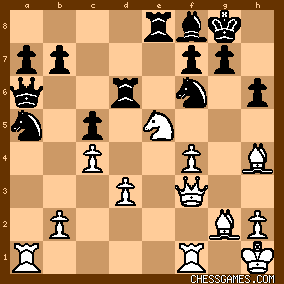
click for larger view
One tactical point of interest is that black's rook needs to guard Nf6, because otherwise we have Bxf6 gxf6 Qg3+ with Rg1 and Bd5 to follow, which look like a crushing attack. So, I considered deflecting the rook. The only way I could see how is <29.b4> (attack the pinned Na5) <29...cxb4 30.c5>

click for larger view
To maintain defense of Nf6, black needs <30...Rde6>
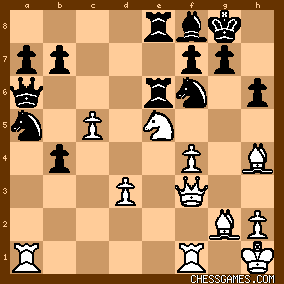
click for larger view
Now, white can take advantage of the freshly vacated c4 square to hit that pinned Na5 with <31.Nc4!>
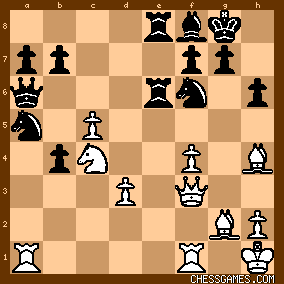
click for larger view
I think I win a piece. |
|
| Jan-06-17 | | NBZ: <YouRang> Coincidentally I had the exact same line, but struggled to find a way to win the piece (in the final position) after 31. ... b6. However it still looks very promising for White; for example, 32. f5 Re2 (or Re7) 33. Bxf6 gxf6 34. Qg4+ with a strong attack. I also considered the game continuation 29. d4 Rxd4 30. Qc3 but thought 30. ...b6 holds for Black. But now I realize White can play 31. b4! the point being that 31. ... axb4 is impossible because of 32. Rxd4. |
|
| Jan-06-17 | | YouRang: <NBZ> Yes, good point. It's nice to have two attacking tactics in the works at once. :-) If 31...b6 shuts down the piece grabbing tactic on the queenside, then 32.f5 renews the rook deflection tactic permitting us to pry open the kingside with Bxf6. |
|
| Jan-06-17 | | diagonalley: "difficult"(?) ... bordering on insane, i would say! ... so many lines to consider... brain hurts :-( |
|
| Jan-06-17 | | belgradegambit: Had the same line as YouRang. Oh well. |
|
| Jan-06-17 | | saturn2: 29 b4 instead of the game line d4 does not give black time for the answer 29..Nh7 |
|
| Jan-06-17 | | DarthStapler: What if cxd4? |
|
| Jan-06-17 | | ventricule: <NBZ> But after 31. b4 black has 31. ... Rxe5 and he emerges miraculously alive because of the pin on the 4th row. The key move is instead 31. Bxf6 where black can not afford to retake with the g pawn without getting crushed on the g file. |
|
| Jan-06-17 | | The Kings Domain: Missed this one. I thought 29) Bxf6 was the ace in the hole. Karjakin was very much outplayed here. |
|
| Jan-06-17 | | dTal: Beautiful and instructive combination starting with 29. d4! which I failed to remotely spot. I was completely on the wrong path, trying N sacs on f7 .. :-( The win is instead based on exploiting the pin of the black N to the Q. Taking the pawn with either R or P seems to lead to a clear win for W (Ventricule, even without 31. Bxf6, W emerges up the exchange? Eg: 30... b6 31. b4 Rxe5 32. fxe5 Rxh4 33. bxa5).
Don't quite see what happens after 29... b6 though. After 29... Qb6 I think 30. Bxf6 when B has to either concede opening his g file or give the N fork on d7. |
|
| Jan-06-17 | | YouRang: <ventricule: <NBZ> But after 31. b4 black has 31. ... Rxe5 and he emerges miraculously alive because of the pin on the 4th row.> Hmm, I don't understand. How does black remain alive after <31.b4 Rxe5 32.fxe5>?
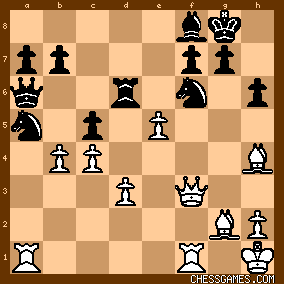
click for larger view |
|
| Jan-06-17 | | wtpy: Took me awhile but I got it. After d4 29..Rd4 I kept trying to make Bf6 work and attack Black's king but then saw 30 Qc3 hitting knight and after the forced b6 that white can now play b4 and win material because black can't capture on b4 because of his now hanging rook on d4. |
|
| Jan-06-17 | | swclark25: good question <DarthStapler> 29)..cxd4 does seem better to preserve the Rook's defense of Nf6. I did look at something like 29)b4 but I could not follow all the way as <YouRang> so nicely did |
|
| Jan-06-17 | | YouRang: <DarthStapler>,<swclark25> <29)..cxd4 does seem better to preserve the Rook's defense of Nf6.> But after 29.d4 cxd4, white hits the pinned N with 30.b4! (thanks to the absence of Pc5).

click for larger view
It's really the confluence of attacks on both black knights that win. It seems that black can cope with one attack or the other, but not both. |
|
| Jan-06-17 | | swclark25: Thanks, the 30)b4 really is ! and the attack on both Knights is rough for black. |
|
Jan-06-17
 | | ajk68: What happens after 29. d4 Qb6, ? |
|
Jan-06-17
 | | ajk68: In answer to my own question, I calculate...
30. b4, If the queen takes then Rfb1, if the pawn takes c5 forks the rook and queen. |
|
| Jan-06-17 | | agb2002: White has the bishop pair for a bishop, a knight and a pawn. The first idea that comes to mind is 29.b4 but after 29... cxb4 30.c5 Re6 31.Bh3 Bxc5 32.Bxe6 Rxe6 Black has three pawns for the exchange. Another option is 29.d4, trying to exploit the pin and an eventually overburdened black queen: A) 29... cxd4 30.b4 wins the knight for two pawns. B) 29... Rxd4 30.Bxf6 gxf6 (30... Qxf6 31.Rxa5 + - [N vs 2P]) 31.Qg4+ and White seems to have compensation for the pawns. For example, 31... Bg7 32.Nf3 Rxc4 33.Nh4 with the threat Nf5, Bd5, Rg1, etc. I haven't found the time for more. |
|
| Jan-06-17 | | mel gibson: The computer agrees but it's not much of a puzzle -
a one pawn advantage:
29. d4 (29. d4 (d3-d4 ♖d6xd4 ♕f3-c3 ♕a6-d6
♕c3xa5 g7-g5 ♘e5xf7 ♔g8xf7 f4xg5 h6xg5 ♗h4xg5 ♗f8-e7 ♕a5-c3 ♖e8-h8 h2-h3
♖h8-h5 ♗g5xf6 ♗e7xf6 ♖a1xa7 ♖d4-d1 ♖a7xb7+ ♔f7-f8 ♕c3-f3 ♖d1xf1+ ♗g2xf1
♖h5-e5 ♗f1-d3 ♖e5-e7 ♖b7-b8+ ♖e7-e8 ♖b8-b3) +1.27/18 99) score = +1.29 depth 18 |
|
| Jan-06-17 | | morfishine: Yes, but are you truly trying to solve these positions 100% visually (so as to improve your true OTB skills), or are you just exploring lines, computer assisted, so one can make posts? Seems like there's a fair amount of murkiness there ***** |
|
| Jan-06-17 | | NBZ: <YouRang> <ventricule> I think ventricule must be referring to the line: 29. d4 Rxd4 30. Qc3 b6 31. b4 Rxe5
click for larger viewA very interesting try. But I feel like White can play 32. Bxf6 here.
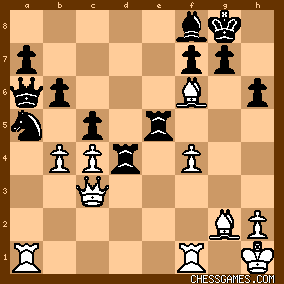
click for larger view(1) 32. ... gxf6 33. fxe5 Rxc4 34. Qg3+ wins
(2) 32. ... Rxc4 33. Qxe5 gxf6 34. Qxf6 Rxb4 35. Bd5 wins. |
|
| Jan-06-17 | | patzer2: Here's a look with Deep Fritz 15 at today's Friday 29. d4! solution: <29. d4! Rxd4>
29... cxd4 30. b4  (+2.90 @ 20 depth) (+2.90 @ 20 depth)
<30. Qc3> This wins but stronger according to the computer is 30. Bxf6! Qxf6 (30... gxf6 31. Rxa5 Qxa5 32.
Qg3+ Bg7 33. Rg1 Rxe5 34. fxe5 Qd2 35. e6 Rd8 36. Bd5 Qg5 37. Qc7 Rxd5 38. Rxg5 Rxg5 39. Qxf7+ Kh7 40. e7  (+9.95 @ 25 depth, Deep Fritz 15)
(+9.95 @ 25 depth, Deep Fritz 15)
31. Rxa5 g5 32. fxg5 Qxe5 33. Qxf7+ Kh8 34. Rxc5 Bxc5 (34... Qxc5 35. Qxe8  #17 @ 25 depth, Deep Fritz 15) #17 @ 25 depth, Deep Fritz 15) 35. g6 Qg7 36. Qxe8+ Qg8 37. g7+ Kh7 38. Be4+ Rxe4 39. Qxe4 + Kxg7 40. Qe5+ Kh7 41. Qxc5  (#12 @ 23 depth, Deep Fritz 15). (#12 @ 23 depth, Deep Fritz 15). P.S.: Black's decisive mistake appears to be the pawn grab 25...Qxa4? allowing 26. Bh4  (+1.65 @ 27 depth, Deep Fritz 15). (+1.65 @ 27 depth, Deep Fritz 15). Instead, 25...b6 26. c4 Qc2 = (0.12 @ 22 depth, Deep Fritz 15) appears to hold it level. |
|
| Jan-10-17 | | ventricule: <NBZ> Right. Stockfish thinks that the best defence there is to give up the exchange with 32. ... Re6 , but this certainly looks grim. |
|





